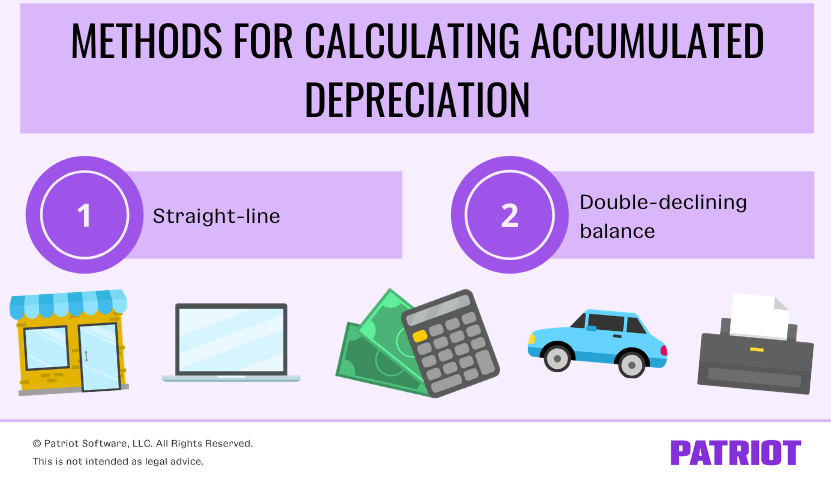As a business owner, you can look to your balance sheet for answers to questions about your business’s financial health. One thing you may keep track of on your balance sheet is accumulated depreciation. But, what is accumulated depreciation?
What is accumulated depreciation?
Accumulated depreciation is the accruing depreciation of an asset. It is the total amount a business’s assets depreciate over time. Basically, accumulated depreciation is the amount that has been allocated to depreciation expense.
For every asset you have in use, there is an initial cost (aka original basis) and value loss over time (aka accumulated depreciation).
Accumulated depreciation is a contra asset account on the balance sheet. This means it’s an asset account that offsets the balance in the asset account it is normally associated with. In short, its balance is a credit that reduces the overall asset value. Unlike a typical asset account, a credit to a contra asset account increases its value and a debit decreases it.
The accumulated depreciation for an asset or group of assets increases over time as depreciation expenses are credited against the assets.
The following assets typically have (or will have) accumulated depreciation:
- Buildings
- Machinery
- Office equipment (e.g., computers)
- Furniture
- Fixtures
- Vehicles
How to calculate accumulated depreciation
There is no standard accumulated depreciation formula. However, there are a couple of ways to calculate accumulated depreciation. Here are the two main methods you can use:
- Straight-line
- Double-declining balance

Straight-line method
The straight-line method is the easiest way to calculate accumulated depreciation. With the straight-line method, you depreciate assets at an equal amount over each year for the rest of its useful life.
To calculate accumulated depreciation with the straight-line method, use the steps below:
- Subtract the asset’s salvage value (the book value of an asset after all depreciation has been fully expensed) from its purchase price to determine the amount that can be depreciated
- Divide the amount from Step 1 by the number of years in the asset’s useful life to get annual depreciation
Annual Depreciation = (Purchase Price – Salvage Value) / Years in Useful Life
Let’s take a look at the straight-line method in action, shall we? Say your business purchases a new machine for $30,000. It has a salvage value of $5,000 and a useful life of 10 years.
$2,500 = ($30,000 – $5,000) / 10 years
Your annual depreciation is $2,500, meaning your asset depreciates $2,500 each year.
If you want to calculate monthly depreciation, simply divide your annual total by 12. For example:
Monthly Depreciation = $2,500 / 12
Your monthly depreciation for the machine would be ~$209.33.
Double-declining balance method
The double-declining balance method accounts for the majority of an asset’s depreciation occurring earlier in its lifespan. With this method, the asset depreciates more quickly in its earlier years, so it uses a depreciation rate of 2.
Check out the double-declining balance formula below:
(Purchase Price – Salvage Value) X ( 1 / Years in Useful Life) X 2
Say you purchase a company vehicle for $50,000. The salvage value is $10,000, and its useful life is 10 years.
(Purchase Price – Salvage Value) X ( 1 / Years in Useful Life) X 2
($50,000 – $10,000) X (1 / 10) X 2
For Year 1, your annual depreciation expense would be $8,000. To find Year 2, subtract the total depreciation expense from the purchase price ($50,000 – $8,000) and follow the same formula.
($42,000 – $10,000) X (1 / 10) X 2
For Year 2, your annual depreciation expense is $6,400.
Continue following this formula for the remaining years to determine how much your asset depreciates over time.
| Year 1 | $8,000 |
| Year 2 | $6,400 |
| Year 3 | $5,120 |
| Year 4 | $4,096 |
| Year 5 | $3,276.80 |
| Year 6 | $2,621.44 |
| Year 7 | $2,097.15 |
| Year 8 | $1,677.72 |
| Year 9 | $1,342.18 |
| Year 10 | $1,073.74 |
How to record accumulated depreciation
So, how do you record accumulated depreciation in your books? Glad you asked. Let’s take a look-see at an accumulated depreciation example using the straight-line method.
You find that your asset’s depreciation for the year is $12,000, or $1,000 per month. Each month, record the following transaction in your books:
| Date | Account | Debit | Credit |
| XX/XX/XXXX | Depreciation Expense | 1,000 | |
| Accumulated Depreciation | 1,000 |
Debit your Depreciation Expense account $1,000 each month and credit your Accumulated Depreciation account $1,000.
Because your Accumulated Depreciation account has a credit balance, it decreases the value of your assets as they increase.
Need a way to record your business’s assets and transactions? Patriot’s online accounting software lets you easily track your income and expenses. And, we offer free, USA-based support. What are you waiting for? Start your free trial today!
This is not intended as legal advice; for more information, please click here.
Leave a Reply